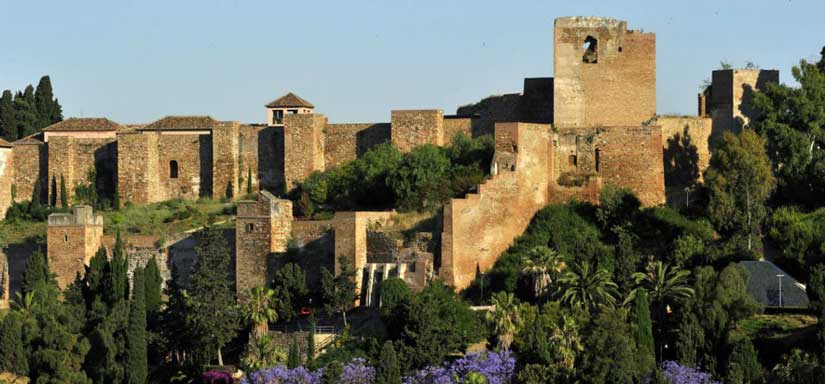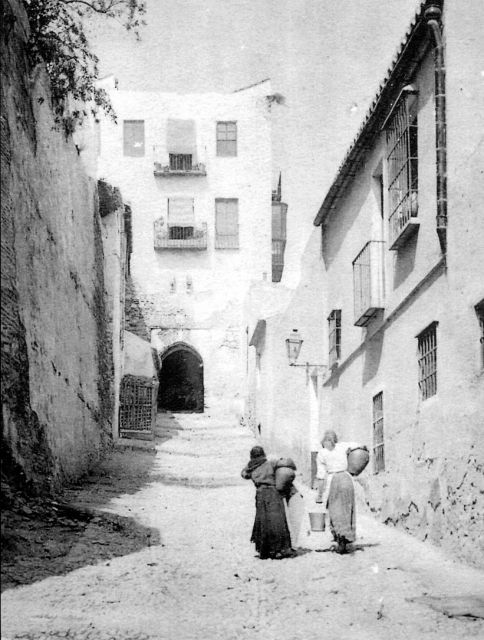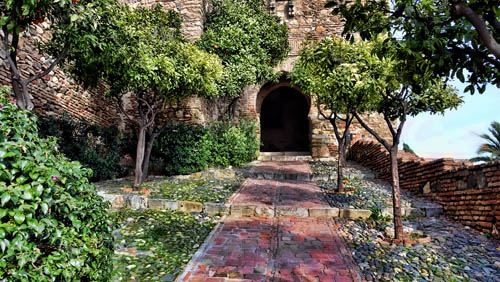The Alcazaba is an ancient Moorish fortress built on a Phoenician fortification that was also used later by the Romans. Without any doubt the situation of this place above the sea with a great view of the area was a great strategic advantage of which every civilization based on the Mediterranean would take advantage.
Located on Mount Gibralfaro and near the centerre of the city with an area of 15000 square meters, however history shows the size of Alcazaba area was more than double than this in the past.

History and legends of the Alcazaba
The Muslim fortress was built in the 10th Century during the Al-Andalus period, this period was from the tenth to the fifteenth century after which the city and the Alcazaba was conquered by the Catholic who used it as a royal residence; later on it would play a military role and then it was abandoned.
The adjacent Roman Theater stone was used in the construction of the Alcazaba and for the initial reforms of towers and walls between the thirteenth and fourteenth centuries.
The military role of this fortress was discontinued from the year 1768 and the fortress abandoned, the most disadvantaged population occupied the interior and exterior of the Alcazaba building houses next to the walls.
Inside the walls it became a dangerous suburb without security nor electricity, two new neighborhood appeared: Alcazabilla and Coracha, two places that only left us images for the memory, legends and stories, some of them as curious as the one of the Alcazaba’s Ghost, an incident that came into the newspapers and with many neighbours as witness; as told in the news a boy thinking it was a real person and not a ghost chased the ghost up inside an empty house without any exit inside, but the entity vanished.

Of the possible Moorish treasures left in the Alcazaba nothing is known, it is possible it was looted by Catholic troops, maybe the gold and jewels were hidden in a near cave or other place as it is known that some Muslim expatriated returned to Andalusia hidden under beggars clothes and then dissapeared leaving behind a trail of golden coins and an empty legend as nothing more was known.
Today the Alcazaba in Malaga is fully renovated and can be visited every day.
How was the Alcazaba back in time?
Much of its original structure has been lost over the centuries, the entrance to the fortress was changed soon after the Catholic conquest. Remains of Roman buildings have been found in later restorations.

There was an area surrounding the Alcazaba, a closed enclosure of large walls and towers. To reach the main palace visitors had to go through up 8 fortified gates and watchtowers, measures which granted great security to all inhabitants of the fortress
Plaza de Armas
The main square is still preserved and they found remains of an ancient mosque in the eight century. From this area you have access to Gibralfaro Castle if you follow the walkway above the wall.
Puerta de los Arcos
Just before reaching the palace is situated the ‘Puerta de los Arcos’, in this area there was a dungeon where prisoners, Cathlic captive women in many cases, where locked inside after a working day.
There are also small gardens with marble sculptures from Roman times.
Alcazaba Palace
There are two palaces, one of the Nazari period and another from the Taifa period, there is also a small neighborhood of homes from eleventh centyry with Arab baths and a central reservoir.
On the central area is where the kings or rulers of the city lived, actually there are cavities and vitrines where ceramic fragments found are exposed.
The last area correspond to a neighbourhood of houses, some with remains of a staircase which leaded in the past to a second floow now vanished. At the end of this district you will find the known as Torre del Homenaje of the fourteenth century with a house on the top but without a preserved access ladder.
Old district of Alcazabilla and the Coracha
Coracha was an old district situated next to the southern side of Alcazaba built by the most disfavoured class of Malaga who used materials of the fortress for building the home next to its walls. This district was expropiated and demolished at the end of the twentieth century and it was replaced with…’access stairs’. Currently only one of those old buildings still on the same place, used as a museum.
Alcazabilla district was located inside the fortress and was definitely an unhealthy place without any security, a guetto where families built their homes.
Finally all those homes were demolished and there began a cleaning process for making of Alcazaba an attractive tourist attraction in Malaga
Alcazaba opening times and price
1 April to 31 October: 9am to 8pm
1 November to 31 March: 9am to 6pm
Closed: 24, 25 and 31 in December and 1st of January.
Prices:
Normal ticket: 2,20€
Visiting Alcazaba and Gibralfaro: 3,55€
Reduced price for residents: 0,60€
Free visit on Sundays from 2pm until close.
About Alcazaba
Address: Calle Alcazabilla, 2, 29012 Málaga, Spain
Phone: +34 630 93 29 87
How to get to the Alcazaba?
The Alcazaba fortress is very close to the city centre, it is a perfect place to visit during your walk through the old town.
If you drive you can use a public park located after passing the tunnel next to the fortress, you will reach it driving once you pass by the Paseo del Parque, leaving the Port of Malaga to your right.


